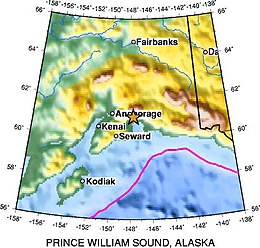1964 Alaska earthquake

Fourth Avenue in Anchorage, Alaska, looking east from near Barrow Street. The southern edge of one of several landslides in Anchorage, this one covered an area of over a dozen blocks, including 5 blocks along the north side of Fourth Avenue. Most of the area was razed and made an urban renewal district.
|
|
 |
|
| Date | 27 March 1964 (AKST) |
|---|---|
| Duration | 4-5 minutes. |
| Magnitude | 9.2 Mw |
| Depth | 14 miles (23 km) |
| Epicenter | 61°3′0″N 147°28′48″W / 61.05000°N 147.48000°W |
| Type | Megathrust |
| Areas affected | United States, Canada |
| Total damage | $311 million |
| Max. intensity | XI (Extreme) |
| Peak acceleration | 0.18 g |
| Tsunami | Major. Run-up of 67 m (220 ft) at Shoup Bay, Alaska. |
| Casualties | 139 killed |
The 1964 Alaskan earthquake, also known as the Great Alaskan earthquake and Good Friday earthquake, occurred at 5:36 P.M. AST on Good Friday, March 27. Across south-central Alaska, ground fissures, collapsing structures, and tsunamis resulting from the earthquake caused about 139 deaths.
Lasting four minutes and thirty-eight seconds, the magnitude 9.2 megathrust earthquake was the most powerful recorded in North American history, and the second most powerful recorded in world history. Soil liquefaction, fissures, landslides, and other ground failures caused major structural damage in several communities and much damage to property. Anchorage sustained great destruction or damage to many inadequately earthquake engineered houses, buildings, and infrastructure (paved streets, sidewalks, water and sewer mains, electrical systems, and other man-made equipment), particularly in the several landslide zones along Knik Arm. Two hundred miles southwest, some areas near Kodiak were permanently raised by 30 feet (9.1 m). Southeast of Anchorage, areas around the head of Turnagain Arm near Girdwood and Portage dropped as much as 8 feet (2.4 m), requiring reconstruction and fill to raise the Seward Highway above the new high tide mark.
In Prince William Sound, Port Valdez suffered a massive underwater landslide, resulting in the deaths of 30 people between the collapse of the Valdez city harbor and docks, and inside the ship that was docked there at the time. Nearby, a 27-foot (8.2 m) tsunami destroyed the village of Chenega, killing 23 of the 68 people who lived there; survivors out-ran the wave, climbing to high ground. Post-quake tsunamis severely affected Whittier, Seward, Kodiak, and other Alaskan communities, as well as people and property in British Columbia, Washington, Oregon, and California. Tsunamis also caused damage in Hawaii and Japan. Evidence of motion directly related to the earthquake was also reported from Florida and Texas.
...
Wikipedia
